
Other info:

U.S. Geological Survey
Open-File Report 03-441
Home > data > vibracores > sketches, descriptions & photographs > north coast
 |
Other info: |
|
Vibracore 27V1, north coast Upward-coarsening succession of vaguely-laminated to bioturbated, medium- to coarse-grained, algal/coral/foraminifera carbonate sand: massive appearing (owing to extensive bioturbation) with oriented large, disarticulated and non-abraded pecten bivalves (Chlamys sp., 1.5-2.5 cm; subparallel to bedding and mostly concave down); light olive gray (5Y6/1) to moderate yellowish brown (10YR5/4) in upper 0.7 m); moderate sorting; sand size clasts angular to rounded; composed mainly of a mix of calcareous algae (36.0-42.5%), coral fragments (23.5-33.0%) and foraminifera (16.5-19.0%); common carbonate rock fragments (3.5-7.5%); minor echinoid fragments (1.0-2.0%), mollusks (2.0-3.5%) and Halimeda (0.5-3.5%). Carbonaceous, silty and slightly sandy mudstone with thin (2-3 mm) layers of highly carbonaceous mud and thin sandy layers (1-2 cm thick); probable burrows (sand-filled); brownish gray to black (5YR4/1-2/1 & N1). Thin, muddy, poorly-sorted, medium- to coarse-grained, olive gray (5Y4/1) sand at base with foraminifers and shell fragments. |
Click either image for larger views (98 kb) 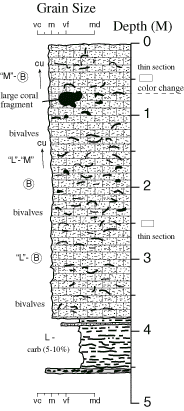 |
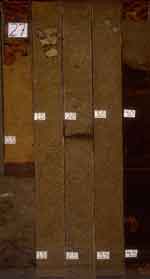 |
| Vibracore 28V1, north coast
Uniform succession of vaguely-laminated to bioturbated, fine-to medium-grained, foraminiferal/algal/coral carbonate sand: massive appearing (no obvious sedimentary structures) owing to extensive bioturbation; light brownish gray (5YR6/1); moderately well sorted; minor pecten bivalves (Chlamys sp.); sand size clasts angular to subrounded; composed mainly of a mix of foraminifera (29.0%), calcareous algae (24.5%) and coral fragments (21.5%); common Halimeda (6.0%). Upward-fining succession of vaguely-laminated to bioturbated, fine-to medium-grained, algal/coral/foraminifera carbonate sand: massive appearing (no obvious sedimentary structures) owing to extensive bioturbation; olive to light olive gray (5Y4/1-6/1); moderate sorting; common, disarticulated and fragmented pecten bivalves (Chlamys sp.), commonly oriented concave down and subparallel to bedding; sand size clasts angular to rounded; composed mainly of a mix of calcareous algae (33.5%), coral fragments (28.0%) and foraminifera(17.5%); common Halimeda (5.0%) and carbonate rock fragments (7.0%). |
Click either image for larger views (94 kb) 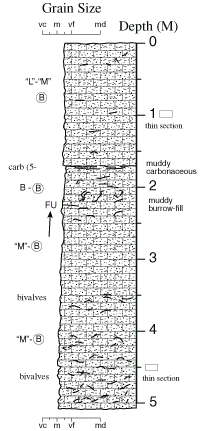 |
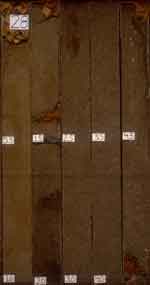 |
| Vibracore 29V1, north coast
Upward-fining succession of burrowed to bioturbated, fine to medium-grained, algal/coral/foraminifera carbonate sand: moderate yellowish brown (10YR7/4) in lower part grading up to light olive gray (5Y6/1); moderate sorting; common large (1.5-3.0 cm), pecten bivalves (Chlamys sp.) oriented subparallel to bedding; sand size clasts angular to rounded; composed mainly of a mix of calcareous algae (31.0-36.5%), coral fragments (26.5-32.0%) and foraminifera (17.0-19.5%); common volcanic rock fragments (4.0-4.5%), carbonate rock fragments (5.0%) and Halimeda (3.0-3.5%); minor echinoid fragments (1.5-4.5%). Upward-fining succession of vaguely-laminated to bioturbated, fine to medium-grained, algal/coral/foraminifera carbonate sand: pale yellowish brown (10YR6/2) to light brownish gray (5YR6/1); moderate sorting; common large (1.5-2.5 cm), disarticulated pecten bivalves (Chlamys sp.), some oriented subparallel to bedding; sand size clasts angular to rounded; composed mainly of a mix of calcareous algae (29.5-35.5%), coral fragments (24.0-35.0%) and foraminifera (16.5-19.5%); abundant volcanic rock fragments (6.0-10.5%); common Halimeda (2.0-4.5%); minor echinoid fragments (2.0-3.0%) and mollusks (1.5%). |
Click either image for larger views (78 kb) 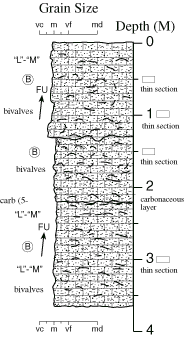 |
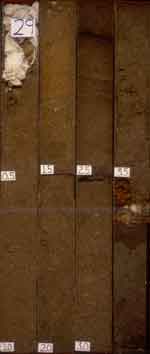 |
| Vibracore 30V1, north coast
Massive-appearing (bioturbated?), very fine to medium-grained, foraminiferal/algal/coral carbonate sand: pale yellowish brown (10YR6/2); moderately well sorted; composed mainly of a mix of foraminifera (29.0%), calcareous algae (21.0%), and coral fragments (20.5%); common volcanic rock fragments (6.5%) and Halimeda (7.0%). Upward coarsening succession of burrowed to bioturbated, fine to very coarse-grained, algal/coral/foraminifera carbonate sand: massive appearing owing to extensive bioturbation; olive gray (5Y6/1-4/1) to grayish orange (10YR7/4) ; very poorly sorted; abundant large (1.5-2.5 cm), disarticulated and fragmented pecten bivalves (Chlamys sp.) and coral fragments; sand size clasts angular to rounded; composed mainly of a mix of calcareous algae (29.5-46.0%), coral fragments (20.5-25.0%) and foraminifera (13.5-14.0%); common carbonate rock fragments (6.0-11.0%) and volcanic rock fragments (2.0-9.5%); minor echinoid fragments (2.0%), mollusks (1.5-5.0%), Halimeda (0.5-3.5%) and calcareous sponge spicules (1.5-4.5%). Massive-appearing (bioturbated?), fine to medium-grained, algal/coral/foraminiferal carbonate sand: pale yellowish brown (10YR6/2); moderately well sorted; composed mainly of a mix of calcareous algae (28.0%), coral fragments (22.5%) and foraminifera (20.5%); common volcanic rock fragments (8.0%) and Halimeda (6.5%). Vaguely-laminated to bioturbated, medium- to coarse-grained, foraminiferal/algal/coral carbonate sand: pale yellowish brown (10YR6/2); very poorly sorted; composed mainly of a mix of foraminifera (27.5%), calcareous algae (34.0%) and coral fragments (16.0%); common carbonate rock fragments (13.0%). |
Click either image for larger views (96 kb) 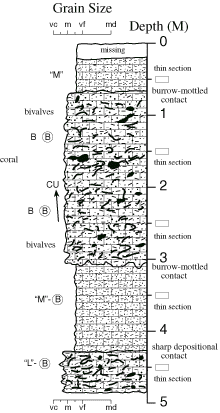 |
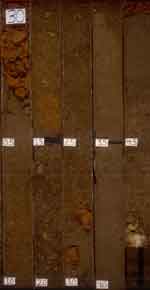 |
| Vibracore 31V1, north coast
Massive-appearing (bioturbated), pebbly, medium- to very coarse-grained, algal/coral/foraminiferal carbonate sand: grayish orange (10YR7/4); very poor sorting; sand and pebble size clasts rounded to well rounded; composed mainly of a mix of calcareous algae (47.5%), coral fragments (15.5%) and foraminifera (11.0%); common carbonate rock fragments (8.5%) and mollusks (11.0%). Uniform succession of vaguely-laminated to bioturbated, fine- to coarse-grained, coral/algal/foraminiferal carbonate sand: massive appearing owing to extensive bioturbation; light olive gray (5Y6/1); moderate sorting; common large (2.5-5.0 cm), disarticulated and fragmented pecten bivalves (Chlamys sp.), some oriented subparallel to bedding; sand size clasts angular to rounded; composed mainly of a mix of coral fragments (38.5%), calcareous algae (28.5%) and foraminifera (16.0%); common carbonate rock fragments (6.0%), minor echinoid fragments (3.0%), mollusks (2.0%) and Halimeda (2.0%). |
Click either image for larger views (96 kb) 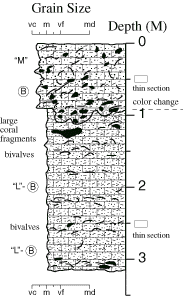 |
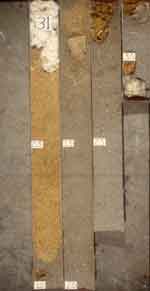 |
| Vibracore 32V1, north coast
Uniform succession of massive-appearing (bioturbated), fine- to medium-grained, algal/coral/foraminiferal carbonate sand: light brownish gray (5YR6/1); moderately well sorted; sand size clasts angular to rounded; composed mainly of a mix of calcareous algae (24.5-29.0%), coral fragments (24.0-24.5%) and foraminifera (24.0-25.0%); common volcanic rock fragments (4.5-7.0%) and Halimeda (7.5-8.0%); minor echinoid fragments (2.0-4.0%) and carbonate rock fragments (2.5%). |
Click either image for larger views (84 kb) 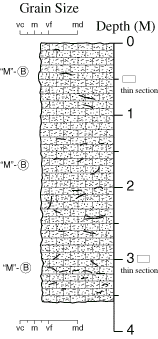 |
 |
| Vibracore 33V1, north coast
Uniform succession of vaguely-laminated to bioturbated, fine- to medium-grained, foraminiferal/algal/coral carbonate sand: massive appearing owing to extensive bioturbation; light brownish gray (5YR6/1); moderate sorting; common large (1.5-2.5 cm), disarticulated and fragmented pecten bivalves (Chlamys sp.), some oriented subparallel to bedding; locally large (1-2 cm) coaly fragments; sand size clasts angular to rounded; composed mainly of a mix of foraminifera (29.5-35.0%), calcareous algae (15.5-26.5%) and coral fragments (20.5-25.0%); common volcanic rock fragments (2.5-3.5%), carbonate rock fragments (2.5-3.5%) and Halimeda (4.5-5.5%); minor echinoid fragments (1.5-3.5%) and mollusks (1.0-2.0%). |
Click either image for larger views (88 kb) 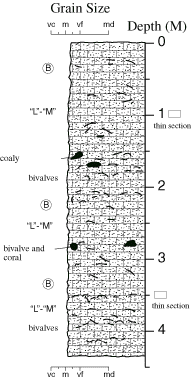 |
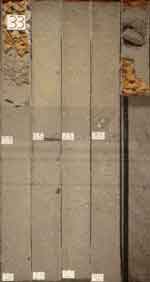 |
| Vibracores 34V1 and 35V1, north coast
Vibracore 34V1, north coast |
Click either image for larger views (73 kb)  |
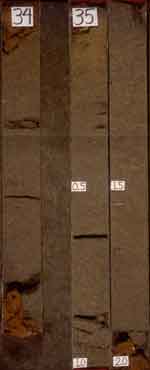 |
| Vibracore 36V1, north coast
Uniform succession of vaguely-laminated to bioturbated, fine- to coarse-grained, algal/coral/foraminiferal carbonate sand: massive appearing (no obvious sedimentary structures) owing to extensive bioturbation; light olive gray (5Y6/1); moderate sorting; common large (1.5-2.5 cm), disarticulated and fragmented pecten bivalves (Chlamys sp.), some oriented subparallel to bedding); sand size clasts angular to rounded; composed mainly of a mix of calcareous algae (39.5-40.5%), coral fragments (20.0-26.5%) and foraminifera (20.0-23.0%); common carbonate rock fragments (5.5-11.0%) minor echinoid fragments (1.0-2.0%), mollusks (2.0-3.0%) and Halimeda (1.0-2.0%). |
Click either image for larger views (68 kb) 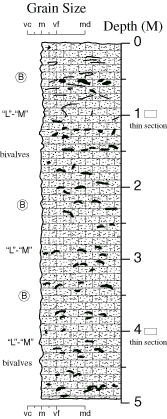 |
 |
| Vibracore 37V1, north coast
Uniform to subtly upward-coarsening succession of massive-appearing (bioturbated), fine- to medium-grained, algal/foraminiferal/coral carbonate sand: light olive gray (5Y6/1); moderate sorting; minor large (1.5-2.5 cm), disarticulated and fragmented pecten bivalves (Chlamys sp.), some oriented sub-parallel to bedding); locally large (3-5 cm) algal nodules; sand size clasts angular to rounded; composed mainly of a mix of calcareous algae (36.5-38.0%), foraminifera (23.0-25.0%) and coral fragments (20.5-21.5%); common carbonate rock fragments (6.0-8.5%) and Halimeda (2.5-6.5%); minor echinoid fragments (2.0-2.5%) and mollusks (1.5%). |
Click either image for larger views (64 kb) 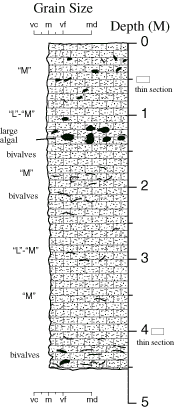 |
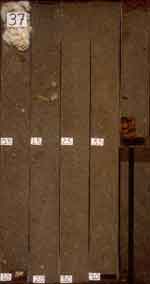 |
|
Top of page
|
http://geopubs.wr.usgs.gov/open-file/of03-441/data/vibracore/descriptions/nocoast.html
For more information, please contact: Monty Hampton
Pages created and maintained by Laura Zink Torresan
last modified 15 December 2003 (cad)
USGS Privacy Statement | Disclaimer | Feedback | Accessibility
Department of the Interior U.S. Geological Survey Geologic Division
Coastal & Marine Geology Program Western Region Coastal & Marine Geology Team